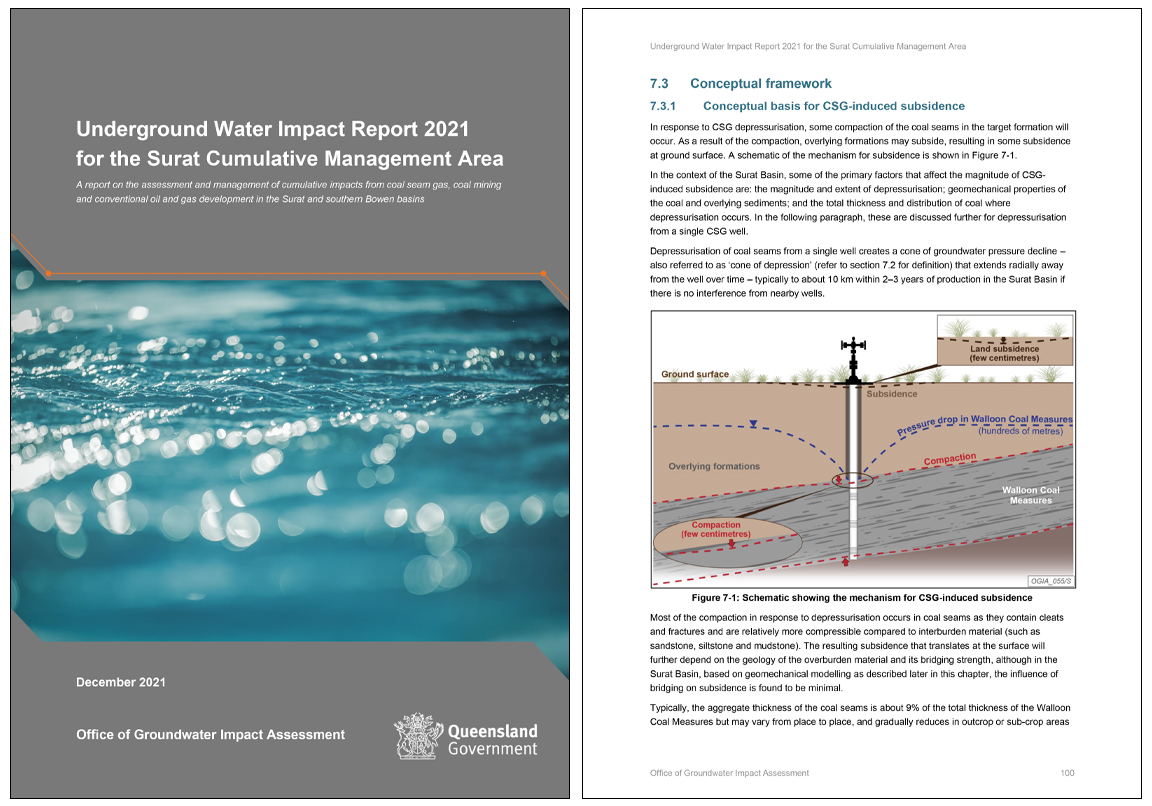GasFields Commission commences key subsidence research project
After extensive engagement with Western Downs landholders and agricultural peak bodies, the GasFields Commission Queensland (the Commission) has identified the issue of coal seam gas induced subsidence (CSG-induced subsidence) as a significant concern of landholders in areas of intensively farmed land, particularly on the Condamine Floodplain.
Landholders and agricultural peak bodies have raised concerns with the Commission about the adequacy of the regulatory framework and processes used to monitor, assess and remedy potential subsidence-related impacts.
Some farming operations rely heavily on irrigation practices and these properties are often ‘laser-levelled’ to optimise overland flow and drainage. According to these landholders, any change in slope as a result of CSG-induced subsidence has the potential to have an impact on the productivity and profitability of their farming operations.
The independent Office of Groundwater Impact Assessment (OGIA) undertook the first comprehensive assessment of subsidence in late 2021 with extensive stakeholder engagement and support. The assessment is detailed in the Underground Water Impact Report 2021 for the Surat Cumulative Management Area (released in March 2022).
Importantly, OGIA has confirmed that CSG-induced subsidence has occurred and is predicted to occur in the future based on current CSG development patterns. However, OGIA’s assessment of subsidence did not deal with consequential risk and mitigation measures as they were outside their legislative scope.
Critical to understanding the issue of CSG-induced subsidence is a robust scientific understanding of the potential risk of impact of this phenomenon affecting intensive farming operations that are heavily reliant on slope. This issue has been identified as a ‘knowledge gap’ that requires urgent action to be addressed.
For this reason, the Commission has commenced a significant research project into the potential impacts and risks to farming operations resulting from CSG-induced subsidence – and how these impacts may be assessed and remedied, should they occur. This project builds on the subsidence assessment work undertaken by OGIA as part of the Underground Water Impact Report 2021 for the Surat Cumulative Management Area.
The purpose of the research is to “develop a framework for assessing, at a farm-scale, risk to farming operations on intensively farmed land, arising from predicted CSG-induced subsidence”. The research will focus on seeking to understand impacts of CSG-induced subsidence, change in slope and what this might mean in terms of on-farm management.
The project outcomes proposed include:
- a framework for assessing the risk to farm management in terms of likelihood of predicted changes to farm slope and consequences for farm management;
- an assessment of risk at a regional scale made using the risk assessment framework; and
- guidance on how the risk assessment framework might be integrated into a regulatory framework.
In undertaking the research in a collaborative way, the Commission will initiate appropriate governance arrangements and targeted consultation with key stakeholders to ensure transparency of the project and its findings.
The State Government is strongly supportive of this body of research and has committed to providing the Commission with the necessary support and assistance in its delivery.
The Commission’s CEO Warwick Squire commented, “Understanding the potential consequences and materiality of subsidence on farming operations is key to understanding the risk associated with CSG development throughout Queensland.
“The issue of CSG-induced subsidence is top of mind for many landholders situated where farming operations with a high dependence on slope to manage irrigation and gas development activities coexist.
“This research will see the Commission once again leading the conversation around complex coexistence matters and partnering with key stakeholders to provide vital science and information, with the aim of improving coexistence outcomes for rural landholders and the onshore gas sector.”
Who are the GasFields Commission Queensland?
Established as an independent statutory body in 2013, the Commission’s purpose is to manage and improve the sustainable coexistence of landholders, regional communities and the onshore gas industry in Queensland. The Commission manages sustainable coexistence in petroleum and gas producing regions of Queensland, and will continue to do so as the industry expands into new and emerging basins.
Our vision is to achieve thriving communities in areas of gas development that are free from discord and supported by well-informed, respectful and balanced stakeholder relationships.
One way the Commission is endeavouring to realise this vision is by providing transparency and independent assurances that the onshore gas industry is appropriately regulated and held to account when needed. This in turn will help cultivate sustainable coexistence, whilst ensuring community and landholder confidence in the regulators and gas industry increases.
Drawing on its wealth of experience in the development of the gas industry and by collaborating with other relevant entities, the Commission provides a range of support to communities and landholders, primarily through education and engagement. These education and engagement activities occur with individual landholders via Commission facilitated webinars, information sessions, publications (The Gas Guide, Shared Landscapes Reports), face-to-face meetings and public workshops.
It should be noted that the Commission does not engage in individual negotiations between landholders and gas companies, but rather provides communities and landholders with the information and support they need to make informed decisions and achieve good outcomes.
Latest Articles
Proposed legislation to expand GasFields Commission’s remit
![]()
What are your views on the onshore gas industry and GasFields Commission Queensland?
![]()
Coexistence challenges and opportunities
![]()
Join the conversation to enhance coexistence in Queensland
![]()
Corrigendum to the report: Review of the Regional Planning Interests Act 2014 Assessment Process
![]()

